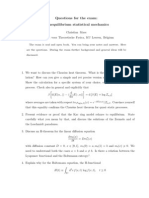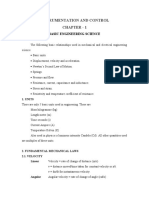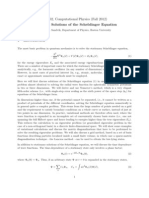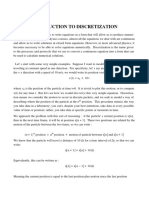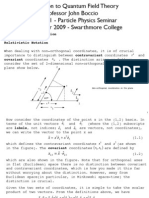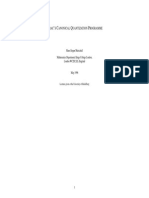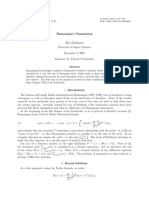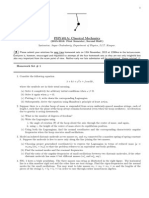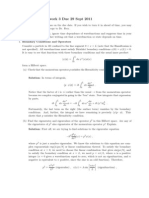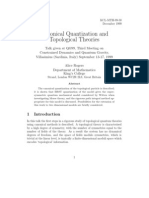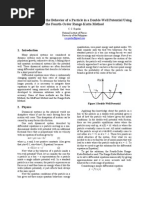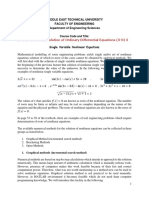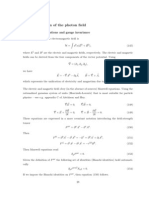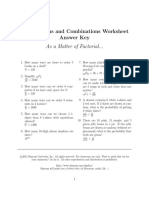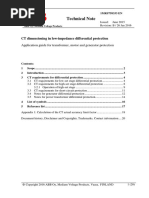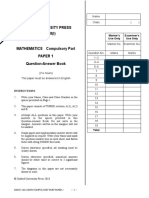Preliminaries: What You Need To Know: Classical Dynamics
Preliminaries: What You Need To Know: Classical Dynamics
Uploaded by
jamescraig229Copyright:
Available Formats
Preliminaries: What You Need To Know: Classical Dynamics
Preliminaries: What You Need To Know: Classical Dynamics
Uploaded by
jamescraig229Original Title
Copyright
Available Formats
Share this document
Did you find this document useful?
Is this content inappropriate?
Copyright:
Available Formats
Preliminaries: What You Need To Know: Classical Dynamics
Preliminaries: What You Need To Know: Classical Dynamics
Uploaded by
jamescraig229Copyright:
Available Formats
Preliminaries: What You Need To Know
Quantum eld theory draws heavily from a number of previous courses, both mathematical and physical. Here I summarize the key concepts that you will need throughout this course. This will also serve to set conventions and notations. If youre not comfortable with any of these concepts or terms, you should review a suitable book as soon as possible.
Classical Dynamics
Well need both the Lagrangian and Hamiltonian formulation of dynamical systems. Recall that a physical system is described by coordinates qa , a = 1, . . . , n whose dynamics are governed by a Lagrangian L = L(qa , qa ). The action is dened by
t2
S=
t1
L(qa , qa ) dt
(1.1)
The true path taken by the system is an extremal of the action, i.e. S = 0. This leads to the equations of motion, d dt L qa L =0 qa (1.2)
An important result from classical dynamics that will carry over to eld theories is Noethers theorem. Lets review this theorem: it states that every continuous symmetry gives rise to a conserved quantity. Consider an innitesimal transformation qa = Xa (q, q, t) (1.3)
This is a symmetry if L = 0 for all paths1 . To prove Noethers theorem, consider an arbitrary deformation qa . Then L = where Q= L qa qa (1.5) L L qa + qa qa qa = L d qa dt L qa qa + dQ dt (1.4)
When the equations of motion are obeyed, the term in brackets vanishes and we have L = Q. Since the symmetry transformation qa = Xa (q, q, t) is dened to have L = 0, we learn that when the equations of motion are obeyed, Q = (L/ qa )Xa is a conserved = 0. quantity, i.e. Q
In fact we can relax this condition and ask only that L = dF/dt, so that the action remains unchanged for all paths.
1
To move towards the Hamiltonian formalism, we dene the momentum pa conjugate to qa pa = L qa (1.6)
The Hamiltonian of the system is then dened as H(q, p) = pa qa L (1.7)
where H is to be considered a function of qa and pa rather than qa and qa . The equations of motion are now given by Hamiltons equations qa = H pa , pa = H qa (1.8)
Finally, let us recall the Poisson bracket, an important quantity in classical mechanics which aids the leap to the quantum theory. For any functions f (q, p) and g(q, p) on phase space, the Poisson bracket is dened by {f, g} = f g f g a a qa p p qa (1.9)
b In particular, {qa , qb } = {pa , pb } = 0 while {qa , pb } = a .
Quantum Mechanics
In classical mechanics, the state of a system is determined by a point in phase space, specied by (qa , pa ). In contrast, in quantum mechanics, the state of a system is specied by a vector | in Hilbert space. The path from the classical system to the quantum system proceeds by promoting functions f on phase space to operators f acting on the Hilbert space. The map between the two system is given by the relationship between Poisson brackets and commutators, { , }classical In particular, we have
b [a , qb ] = [a , pb ] = 0 and [a , pb ] = i a q p q
[ , ]quantum
(1.10)
(1.11)
This prescription is known as canonical quantization. Note that a generic classical func tion f (q, p) does not dene a unique quantum operator f due to ordering ambiguities.
The dynamics of a quantum system is governed by the Hamiltonian operator H. There are two dierent ways of viewing the dynamics. In the Schrdinger picture, the o are time independent. The dynamics states | evolve in time, while the operators O is governed by the Schrdinger equation, o d | S = H | S (1.12) dt where the subscript on | S reminds us that were in the Schrdinger picture. In o contrast, in the Heisenberg picture, the states are time independent, while the operators now change with time. The relationship between the two is given by i | H = eiHt/ | S OH = eiHt/ OS eiHt/ and the operators now evolve by dO H i = [H, OH ] dt (1.15)
(1.13) (1.14)
Note that HS = HH H. The two pictures are entirely equivalent since all correlation functions | O | agree. In quantum eld theory we will jump merrily between these two dierent pictures. We will also employ a third viewpoint which is something of a hybrid of the rst two, known as the interaction picture. In this course our notation will dier slightly from that above. Firstly, we will work in natural units with = 1. Secondly, we will not denote operators with a hat; it should be clear from the context whether were talking about classical objects or quantum objects.
Special Relativity
Minkowski space is parameterized by coordinates x = (x0 , xi ), where = 0, 1, 2, 3 and i = 1, 2, 3. We will often denote x0 as time t, and the spatial three vector xi as x. (On the blackboard, the 3-vector will have a wavy line on the bottom rather than an arrow on top). We will work in units in which the speed of light is set to c = 1. The Minkowski metric is then given by 1 1 = = (1.16) 1 1
so that = . We use ( ) to raise (lower) indices on vectors and tensors.
The relativistic line interval is given by ds2 = dx dx = (dx0 )2 dx dx (1.17)
A relativistic particle of mass m traces out a path x (s) in Minkowski space. The 4-momentum p is dened by p = m dx ds (1.18)
which satises p2 p p = (dx /ds)(dx /ds) = m2 . So writing the 4-momentum p = (E, p) in terms of the energy E and the 3-momentum p, we arrive at the relativistic dispersion relationship for a massive particle, E 2 |p |2 = m2 We will denote the energy of a particle of mass m and 3-momentum p as Ep = |p |2 + m2 (1.20) (1.19)
where we take the +ve square root. This quantity will feature a lot in this course! Another quantity that features prominently is the scalar product p x = p x = Et p x (1.21)
A note on indices: throughout this course, we will employ the summation convention in which repeated indices are summed over. For the spacetime indices it will be crucial to keep track of whether theyre up or down: you should never encounter expressions that look like a b . (For the other indices, such as the a = 1, . . . , n index which appear on the qa , we dont need to be as careful, although its good practice to try!). Also, its worth stressing that repeated indices are dummy indices it doesnt matter what you call them. But its very important that you dont use the same pairs of dummy indices twice. For example, the expression (a b )(c d ) makes no sense even with the brackets! Avoid rampant confusion by writing a b c d to show which pairs are summed over. Mistakenly denoting multiple pairs of dummy indices with the same label will be a very easy trap to fall into in this course.
Fourier Transforms
Well be frequently changing from position space to momentum space using the Fourier transform. As always, we have to decide where the factors of 2 sit. Our convention will be dn k f (x) = f (k) eikx (1.22) (2)n
so that the inverse reads f(k) = dn x f (x) eikx (1.23)
Theres now no excuse for losing track of factors of 2: they always accompany momentum integrals, never position integrals. Remember also that if were doing a Fourier transform over spacetime (as opposed to just space) then k x = k 0 x0 k x.
Dirac Delta Functions
The Dirac delta function is dened by (x) = 0 for all x = 0 and
+
dx (x) = 1
(1.24)
The Fourier transform of the delta-function provides a useful representation that we will make extensive use of:
+
(x) =
dk ikx e 2
(1.25)
In an n-dimensional space, the delta-function is given by (n) (x) = dn k ikx e (2)n (1.26)
Complex Functions
There are a few places in the course where well need to make use of the properties of complex functions. In particular, well need the residue theorem. Let be a positively oriented (i.e. anticlockwise) simple closed contour within (and on) which a function f (z) is analytic except for a nite number of singular points z1 , . . . , zn in the interior of . Then
n
f (z)dz = 2i
i=1
bi
(1.27)
where bi is the residue of f (z) at the singular point zi . The residue of a function with an isolated singular point z0 is dened as the coecient c1 of the Laurent expansion of f (z) about z0 ,
f (z) =
n=0
(z z0 )n +
c2 c1 + + ... z z0 (z z0 )2
(1.28)
for 0 < |z z0 | < R, the radius of convergence.
You might also like
- Possible Questions Exam Non-Equilibrium Statistical MechanicsDocument4 pagesPossible Questions Exam Non-Equilibrium Statistical MechanicsEgop3105No ratings yet
- Chapter - 1 - Basic Engineering ScienceDocument8 pagesChapter - 1 - Basic Engineering ScienceMathavaraja Jeyaraman100% (3)
- Preliminaries: What You Need To Know: Classical DynamicsDocument5 pagesPreliminaries: What You Need To Know: Classical Dynamicsclarkalel1No ratings yet
- David Tong QFT PreliminariesDocument5 pagesDavid Tong QFT PreliminariesAngel NavaNo ratings yet
- Sec8 PDFDocument6 pagesSec8 PDFRaouf BouchoukNo ratings yet
- The Relativistic StringDocument19 pagesThe Relativistic Stringrsanchez-No ratings yet
- Qm NotesDocument20 pagesQm Notesalexander.z.knightNo ratings yet
- Numerical Solutions of The Schrodinger EquationDocument26 pagesNumerical Solutions of The Schrodinger EquationqrrqrbrbrrblbllxNo ratings yet
- Wed January 23 Lecture Notes: Coordinate Transformations and Nonlinear DynamicsDocument12 pagesWed January 23 Lecture Notes: Coordinate Transformations and Nonlinear DynamicsSimi ChNo ratings yet
- Ap 3Document45 pagesAp 3MARTÍN SOLANO MARTÍNEZNo ratings yet
- The Calculus of VariationsDocument52 pagesThe Calculus of VariationsKim HsiehNo ratings yet
- Introduction To DiscretizationDocument10 pagesIntroduction To DiscretizationpolkafNo ratings yet
- K K K K 1 K 1 K K 0 K 00Document11 pagesK K K K 1 K 1 K K 0 K 00SHARAVATHI wardensharavNo ratings yet
- Classical Mechanics Notes (4 of 10)Document30 pagesClassical Mechanics Notes (4 of 10)OmegaUserNo ratings yet
- Handout 1Document16 pagesHandout 1Chadwick BarclayNo ratings yet
- Statistical Mechanics Lecture Notes (2006), L30Document4 pagesStatistical Mechanics Lecture Notes (2006), L30OmegaUserNo ratings yet
- Statistical Mechanics Lecture Notes (2006), L3Document5 pagesStatistical Mechanics Lecture Notes (2006), L3OmegaUserNo ratings yet
- CM 06 HamiltonsEqnsDocument6 pagesCM 06 HamiltonsEqnsosama hasanNo ratings yet
- Motion of A Charged Particle in A Magnetic FieldDocument9 pagesMotion of A Charged Particle in A Magnetic FieldJames MaxwellNo ratings yet
- L23 - Postulates of QMDocument24 pagesL23 - Postulates of QMdomagix470No ratings yet
- QFT BoccioDocument63 pagesQFT Bocciounima3610No ratings yet
- Goldstein Classical Mechanics - Chap15Document53 pagesGoldstein Classical Mechanics - Chap15ncrusaiderNo ratings yet
- Zworski Semiclassical 1Document279 pagesZworski Semiclassical 1bensaidsiwar1No ratings yet
- Cauchy Best of Best Est-P-9Document22 pagesCauchy Best of Best Est-P-9sahlewel weldemichaelNo ratings yet
- Weeks3 4Document25 pagesWeeks3 4Eric ParkerNo ratings yet
- Particle Magnetic FieldDocument7 pagesParticle Magnetic FieldShubhanshu ChauhanNo ratings yet
- GwgPartIII SupergravityDocument42 pagesGwgPartIII SupergravityrobotsheepboyNo ratings yet
- Itzhak Bars and Moises Picon - Twistor Transform in D Dimensions and A Unifying Role For TwistorsDocument34 pagesItzhak Bars and Moises Picon - Twistor Transform in D Dimensions and A Unifying Role For TwistorsGum0000No ratings yet
- The Hamiltonian MethodDocument53 pagesThe Hamiltonian Methodnope not happeningNo ratings yet
- D ' C Q P: Irac S Anonical Uantization RogrammeDocument25 pagesD ' C Q P: Irac S Anonical Uantization RogrammeManu SharmaNo ratings yet
- mit8_323_s23_rec02Document6 pagesmit8_323_s23_rec02Hosayn ChibaniNo ratings yet
- Bernhard List Evolution of an extended Ricci flow system communications in analysis and geometry 16(2Document42 pagesBernhard List Evolution of an extended Ricci flow system communications in analysis and geometry 16(2Carlos MaurícioNo ratings yet
- Brief Review of Quantum Mechanics (QM) : Fig 1. Spherical Coordinate SystemDocument6 pagesBrief Review of Quantum Mechanics (QM) : Fig 1. Spherical Coordinate SystemElvin Mark Muñoz VegaNo ratings yet
- NRQMJJ Hamiltonjacobiv1Document9 pagesNRQMJJ Hamiltonjacobiv1Mayaa KhanNo ratings yet
- Ramanujan's SummationDocument6 pagesRamanujan's SummationKen ToadNo ratings yet
- Group 6Document39 pagesGroup 61DT20CS148 Sudarshan SinghNo ratings yet
- HwsDocument12 pagesHwsSaiPavanManojDamarajuNo ratings yet
- Eg 1Document5 pagesEg 1jestamilNo ratings yet
- hw3 SolDocument5 pageshw3 SoltitolasdfeNo ratings yet
- Canonical Quantization and Topological TheoriesDocument8 pagesCanonical Quantization and Topological TheoriesDwi Teguh PambudiNo ratings yet
- Lagrangian Dynamics: 1 System Configurations and CoordinatesDocument6 pagesLagrangian Dynamics: 1 System Configurations and CoordinatesAbqori AulaNo ratings yet
- Xequivalence Between Schrödinger and Feynman Formalisms For Quantum Mechanics The Path Integral FormulationDocument14 pagesXequivalence Between Schrödinger and Feynman Formalisms For Quantum Mechanics The Path Integral FormulationDaniel FerreiraNo ratings yet
- Quantum Field Theory Notes: Ryan D. Reece November 27, 2007Document23 pagesQuantum Field Theory Notes: Ryan D. Reece November 27, 2007jamaeeNo ratings yet
- Functional QF TDocument25 pagesFunctional QF TRandallHellVargasPradinettNo ratings yet
- Implementation of The Behavior of A Particle in A Double-Well Potential Using The Fourth-Order Runge-Kutta MethodDocument3 pagesImplementation of The Behavior of A Particle in A Double-Well Potential Using The Fourth-Order Runge-Kutta MethodCindy Liza EsporlasNo ratings yet
- Numerical Solution of Ordinary Differential Equations Part 2 - Nonlinear EquationsDocument38 pagesNumerical Solution of Ordinary Differential Equations Part 2 - Nonlinear EquationsMelih TecerNo ratings yet
- Elements of Dirac Notation Article - Frioux PDFDocument12 pagesElements of Dirac Notation Article - Frioux PDFaliagadiego86sdfgadsNo ratings yet
- Computation of Determinants Using Contour IntegralsDocument12 pagesComputation of Determinants Using Contour Integrals123chessNo ratings yet
- Quantum Formalism: 1.1 Summary of Quantum States and ObservablesDocument48 pagesQuantum Formalism: 1.1 Summary of Quantum States and Observablesprivado088No ratings yet
- Introduction. Configuration Space. Equations of Motion. Velocity Phase SpaceDocument11 pagesIntroduction. Configuration Space. Equations of Motion. Velocity Phase SpaceArjun Kumar SinghNo ratings yet
- Special Topics in Particle Physics: Robert Geroch April 18, 2005Document121 pagesSpecial Topics in Particle Physics: Robert Geroch April 18, 2005partitionfunctionNo ratings yet
- L4 5 Path IntegralDocument19 pagesL4 5 Path IntegralJohn KahramanoglouNo ratings yet
- Semi Classical Analysis StartDocument488 pagesSemi Classical Analysis StartkankirajeshNo ratings yet
- 4 Quantization of The Photon Field: 4.1 Maxwell Equations and Gauge InvarianceDocument7 pages4 Quantization of The Photon Field: 4.1 Maxwell Equations and Gauge InvarianceMichelle Mesquita de MedeirosNo ratings yet
- VERY VERY - Advanced Dynamics PDFDocument129 pagesVERY VERY - Advanced Dynamics PDFJohn Bird100% (1)
- Associated Legendre Functions and Dipole Transition Matrix ElementsDocument16 pagesAssociated Legendre Functions and Dipole Transition Matrix ElementsFrancisco QuiroaNo ratings yet
- 105 FfsDocument8 pages105 Ffsskw1990No ratings yet
- A-level Maths Revision: Cheeky Revision ShortcutsFrom EverandA-level Maths Revision: Cheeky Revision ShortcutsRating: 3.5 out of 5 stars3.5/5 (8)
- Mean Squared Error - Wikipedia, The Free EncyclopediaDocument6 pagesMean Squared Error - Wikipedia, The Free EncyclopediaAbhijeet SwainNo ratings yet
- Geometric Dimension Ing and Tolerancing (Efunda)Document26 pagesGeometric Dimension Ing and Tolerancing (Efunda)Anonymous zF4syKOrJNo ratings yet
- Lesson PlanDocument4 pagesLesson PlanJUDELYN O. DOMINGONo ratings yet
- Doubly Linked List Polynomial Addition MultiplicationDocument5 pagesDoubly Linked List Polynomial Addition MultiplicationAkshara P SNo ratings yet
- Problem Set 3Document2 pagesProblem Set 3Mailyn ElacreNo ratings yet
- MAA 1.4 GEOMETRIC SEQUENCES EcoDocument13 pagesMAA 1.4 GEOMETRIC SEQUENCES Econc23cyagNo ratings yet
- Grade 9 Las Mathhs q1 w5Document16 pagesGrade 9 Las Mathhs q1 w5박용 원No ratings yet
- Permutations and Combinations Worksheet Answer Key As A Matter of Factorial..Document1 pagePermutations and Combinations Worksheet Answer Key As A Matter of Factorial..Leidel Claude TolentinoNo ratings yet
- Disha Publication Number System Past PapersDocument9 pagesDisha Publication Number System Past PapersLokesh MeenaNo ratings yet
- Problem Chapter4 PDFDocument20 pagesProblem Chapter4 PDFAnup PandeyNo ratings yet
- Easy To Score ManualDocument99 pagesEasy To Score Manualmmabathovilakazi304No ratings yet
- Why Some New Products Are More Successful Than OthersDocument14 pagesWhy Some New Products Are More Successful Than OthersTamiruNo ratings yet
- Eureka School October NewsletterDocument2 pagesEureka School October NewsletterEureka Child FoundationNo ratings yet
- Workera ReportDocument22 pagesWorkera ReportJITENDRA PATELNo ratings yet
- CT Dimensioning in Low-Impedance Differential Protection PDFDocument20 pagesCT Dimensioning in Low-Impedance Differential Protection PDFRafael Lopez100% (2)
- Oxford Core 1 2018Document26 pagesOxford Core 1 2018Ngai Ivan CHANNo ratings yet
- Test 33737282Document267 pagesTest 33737282prathamvkothariNo ratings yet
- 16) Unit 5 - Theory of AttributesDocument42 pages16) Unit 5 - Theory of Attributesrocir84197No ratings yet
- Learning Action Cell (Lac) Action Plan S.Y. 2019-2020Document6 pagesLearning Action Cell (Lac) Action Plan S.Y. 2019-2020Richard S baidNo ratings yet
- Numerical DifferentiationDocument9 pagesNumerical Differentiations. magxNo ratings yet
- Group I Main 2008 PaperIDocument11 pagesGroup I Main 2008 PaperIGanesh VeeraragavanNo ratings yet
- Hardware Implementation of Real-Time Image Segmentation Algorithms Using TMS320C6713 DSP and VM3224K2 Daughter KitDocument4 pagesHardware Implementation of Real-Time Image Segmentation Algorithms Using TMS320C6713 DSP and VM3224K2 Daughter KitJUNAID100% (1)
- 24maths Mock 1Document15 pages24maths Mock 1tomoketch1998No ratings yet
- Similar Math Grade 9Document2 pagesSimilar Math Grade 9Trina PamaranNo ratings yet
- The Fibonacci Numbers and Its Amazing Applications: Sudipta SinhaDocument8 pagesThe Fibonacci Numbers and Its Amazing Applications: Sudipta Sinhac4c4No ratings yet
- Travelling Salesperson Problem Using Hill Climbing SearchDocument6 pagesTravelling Salesperson Problem Using Hill Climbing SearchVignesh MNo ratings yet
- Detailed Lesson Plan in Mathematics I .Content StandardsDocument9 pagesDetailed Lesson Plan in Mathematics I .Content StandardsFarrah Joy Aguilar Nietes100% (1)
- LONG - SLENDER - COLUMNS RCDocument27 pagesLONG - SLENDER - COLUMNS RCJoeven DinawanaoNo ratings yet
- The Pumping Lemma For Context Free GrammarsDocument14 pagesThe Pumping Lemma For Context Free GrammarsPiyush KumarNo ratings yet
